Inside outsider language is an exploration into visual and verbal languages. By tying together language and the institution, it attempts to illustrate our dependence on codified references.
Communication in art, whether visual or verbal, uses these references, which we align with what has happened before.
A liminal state is one before a transition, a zone of ambiguity just outside the peripheries of common thought. Just as art advances beyond this threshold, this exhibition works to show how our current language and ability to ‘read’ are extended. Through large-scale installations and sculpture, the exhibition navigates recognizable gestures and language.
With a selection of London-based artists, the exhibition gathers site-specific and never-before seen works that explore this liminal state and the language structures we navigate.
The overall composition hints at the artists’ expanded practices beyond what is immediately tangible.
Exhibition curated by Jack Brindley
2 July – 15 August 2010
Private view: Thursday 1 July, 6.30-9.30pm
Press: Emily Candela, a-n magazine, October 2010
The act of seeing is not autonomous — we perceive through codified visual references supplied by the status quo. The artistic institution perpetuates and solidifies the visual language that structures both art production and art interpretation. This language, however, is also structured by art production and art interpretation, creating complex, self-reflexive relationships. We, as viewers, function within this framework provided by the institution, which reinforces what we deem as acceptable. The result is the historical context through which we read art. Language and institution both present themselves within the known, prompting the maintenance of the status quo. The status quo, however, is not a static being; what we find acceptable as an audience evolves through time. But what provokes the language and institution to change?
Artists are subject to practical limitations and the working structures available to them are restricted to certain a priori genres that give form to their ideas. Contemporary art is a re-working of previous sentiments to instigate new forms of expression. This exhibition aims to examine such re-working of accepted visual and material forms and to look back to how boundaries have been pushed outward until that which had been consistently marginalized by the institution became embraced by it.
This process of incorporation begins with the liminal gesture. The liminal state is one before the threshold of understanding, a zone of ambiguity just outside the peripheries of common thought. It is exterior to language and other recognizable systems. The gestures that exist within this state are abstract and alien, which pressures us to attach the network of codified references supplied by the institution.
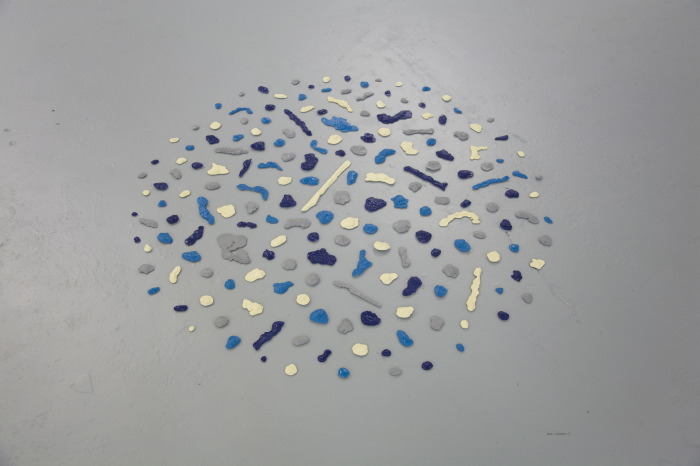
Dave Hanger’s Hind-Sight (2010) mirrors sections of the gallery floor, casting them in pewter prior to the gallery’s restoration. These gestures are obscure; it is not particularly clear where they originated. The desire to align our perception of this action with previous experience resolves easily in that we can comfortably place this work within the known. Looking at Hind-Sight, we are almost reminded of Tony Cragg’s systematic, chromatic arrangement of discarded materials. Both Cragg’s work and Hanger’s sculptures involve a process of detailed cataloguing of various insignificant visual stimuli. The colours in Hind-Sight, however, originate from the vinyl flooring of the 38 London bus route. Looking at the work, we may be unsure of how to navigate the combination of these two influences. Forcing gestures into the recognizable linear history causes us to question our application of visual language to the liminal action. The visual language of interpretation begins to expand to include the liminal when we apply a history of references to each work.
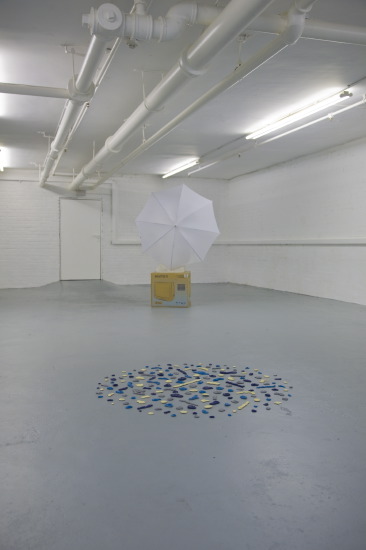
Amikam Toren, Fragile, 2003-04
So it seems that any attempt to stray from acceptable frameworks only serves to reinforce them, albeit in an expanded state. History can be re-read through reinterpretations of itself; its boundaries are not fixed as the sociological context changes. The status quo and its institutionalized language become crucial in its apparent limitations. By providing a boundary, the status quo also supplies the opportunity for the boundary to be transgressed. Views such as institutional critique were once revolutionary but have now been assumed into the fabric of art and its potential ground for commentary. Every popular subversive act will become a chapter in history because the museum has an obligation to catalogue movements and trends. Artists have moved on from critiquing the ‘white cube’ to a broader range systems, pushing political, economic and social boundaries. Jill Magid’s recent project Authority to Remove was exhibited at Tate Modern, displaying text she created while working on a commission for the new headquarters AIVD, the Dutch Secret Service. While AIVD granted Magid unparalleled access to information about agents within the organization, the organization ultimately censored the final work because it would have been a breach of security. After the artist protested, AIVD allowed the subsequent display of the work on the condition that it would only be shown once. This hesitation in exhibition of the project lead to a direct role reversal between the citizens and their governmental agencies. Those in positions of authority were under the scrutiny of those typically surveilled by them.
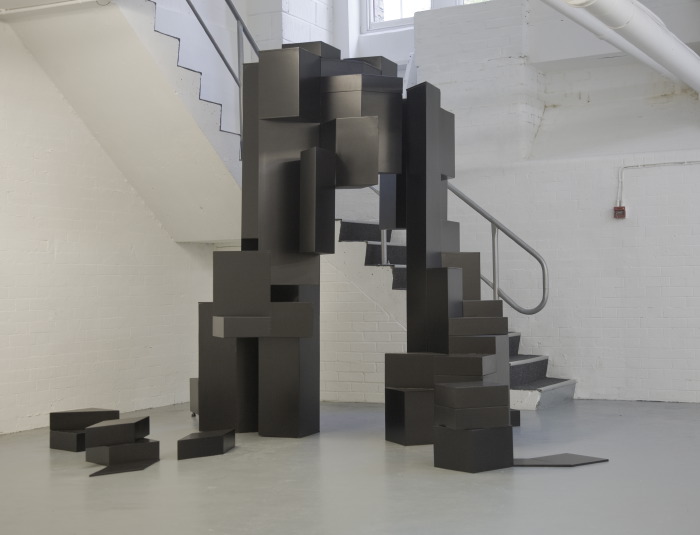
The works in this exhibition are not socio-political protests against an oppressive institution. They make apparent an awareness of their situation within the context of contemporary art. The works ask us to look backwards; through the artists’ use of specific materials, previous statements are reinterpreted. No material has the power to exist by itself — when confronted with Ami Clarke’s Folly (2006), we immediately recall the mammoth Minimalist sculptures of the 1960s. Folly, however, is not based on the sculptures it ostensibly mimics. Instead, Clarke employs varied subject matter as the origin of her ideas, yet is far more interested in the process of development rather than the final product. With Folly, she began with a Persian design and through the process of rebuilding it like a puzzle, hints at previous forms. By navigating the systems put in place by the status quo, and actively using them to understand the art object, we can move past the boundaries with the artist to expand the canon of the institution. Looking back at Minimalism through Clarke’s structures, we see Donald Judd’s sculptures not just as specific objects, but also as architectural monuments.
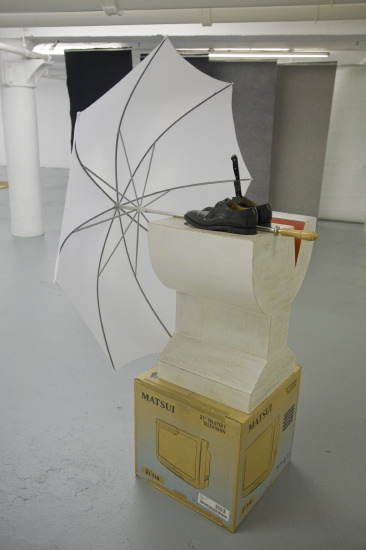
By moving past the explicit material form of the works with the idea of ‘post-materiality’, we begin to understand the physical object has implicit historical references. Materials have previous assignments, and by appropriating those, the artists in this exhibition allude to a larger context. Amikam Toren’s Fragile (2003) groups together a collection of seemingly unconnected objects and we are un-certain of how to locate their context. The wine glass, knife and umbrella are difficult to place in a descriptive system. However potential Dada-esqe attributes are dismissed as we connect their symbology to a specific context and decode their references. Fragile elusively hints at the handling and care of an object in transit. Toren’s practice often comments on the unseen economic aspects of art and its international market; the artist playfully engages in the display and commercial role of art. In 1999, he whitewashed the windows of a commercial West-End gallery, closing the space for the duration of his exhibition. Although highly critical of the socio-economic status of the art world, Toren maintains a Joseph Beuys-like humour. Through monumentalizing gestures and symbols, the physicality of the work becomes an entry-point into art’s references and potential for commentary.
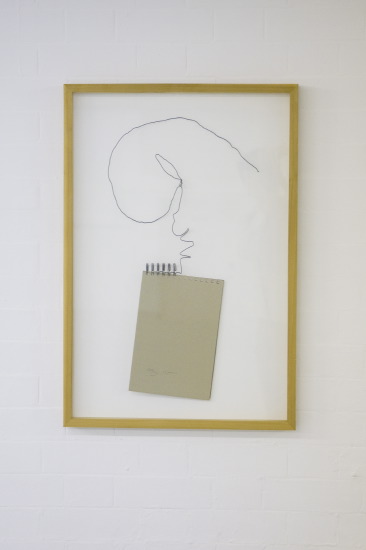
Comparably, the Last Drawing series, also by Toren, discards drawings in favour of their wire and cardboard supports. Each time the artist finishes a sketchbook, a sculptural work is made. The bent wire implies not just a mark made on paper, but also the unseen process involved in the production of the object. Each work signifies the multiple drawings made prior to the construction of the object.
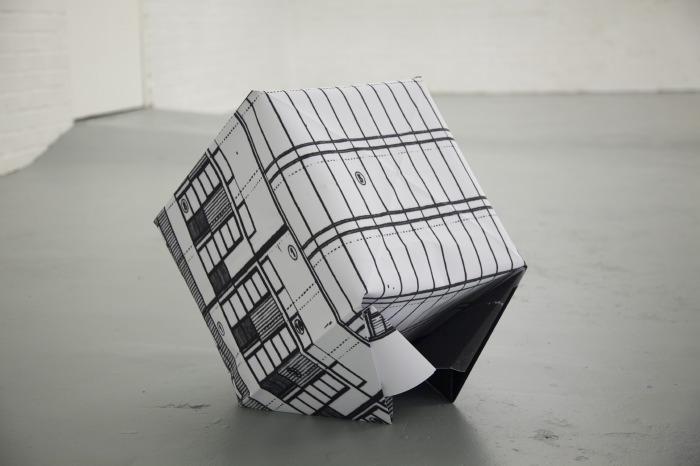
With Untitled (water bomb) (2010), Ami Clarke depicts information with an indecipherable combination of forms. The ability to communicate is hindered by the overlapping of the images and by the folding of the paper. Clarke starts with a variety of sources, from architectural drawings to the timeline for the discovery of the planets, to chart information in a rhizomic fashion. The information she provides has multiple points of entry, and yet all of them are inaccessible. Despite our inability to comprehend fully the content, we engage with the visual languages present in the work.
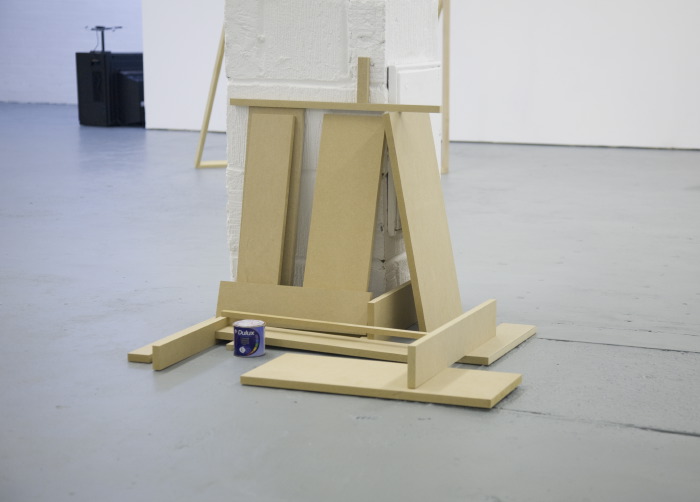
(The mutual interaction of constructive elements and their inherent relations), 2009
Matthew Verdon re-presents Piet Mondrian’s 1939 painting in Composition No. 1 (2009). Verdon’s practice involves looking back to movements like Futurism, Dada and Modernism, all concerned with affecting change within the institution, to explore the potential contained within them. By breaking down the shapes in Mondrian’s work into individual parts, Verdon reduces the iconic image to its barest form. The shapes, constructed out of MDF, are re-arranged daily, flirting with other recognizable forms with which we may identify. Our understanding of this work, however, is firmly rooted in our identification of it as a Mondrian painting: Verdon’s exploration of the potential contained within history creates the sculpture’s value in its contemporary setting. By looking to past movements and re-evaluating them in the present, the artist asks how we can inform the future.
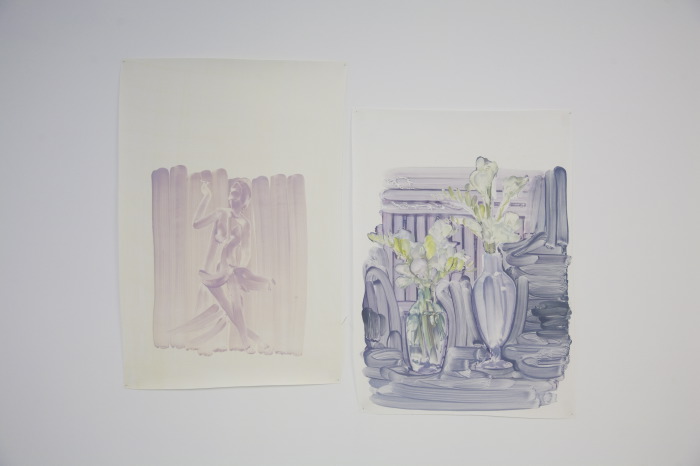
George Young reduces the genres of sculpture and painting to provide a more open dialogue between the forms. The independent and overlapping forms, described by Young as Venn diagrams, prompt a more intricate inquiry into the relationships in our visual vocabulary. By combining wooden sculptures, which resemble stretchers, and paintings on paper attached directly on the walls, Young tempts us to associate his work with Greenbergian ideals: the flatness of painting, the three-dimensionality of sculpture. The materiality of the painting is made evident through the clearly authored application of paint, which in turn contrast with the deliberately rigid wooden structures. Because the painting and the sculpture are a singular piece, however, Young creates an ambiguity that provides us with an open territory to engage with the work.
Dave Hanger takes away both the canvas and the stretcher in Description of a Picture (2008-), located upstairs in the gallery space. Each group of polished wall-mounted sculptures maps the dimensions of an adjacent work. As the canvas is removed, we are left only with the corners of the structure. Although understood through their spatial situation and their material quality, the work gains critical depth when we discover the origins of its form, providing a broader context for the work.
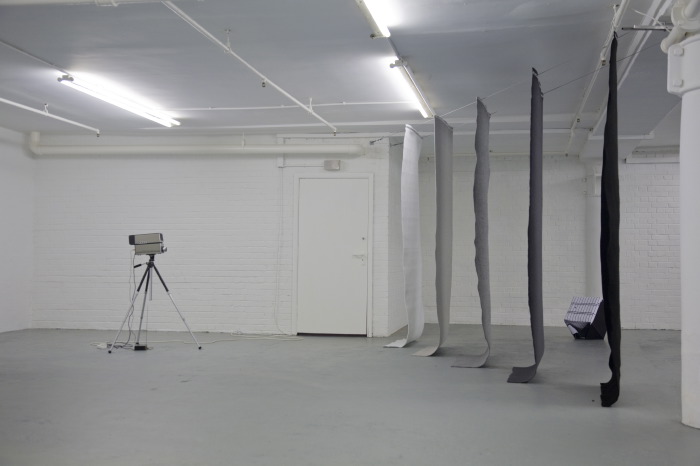
CH21 (2010) by Yuri Pattison similarly engages with unseen structures of production, employing television as its medium. As the image taken by the camera is transmitted on ultra-high frequency radio waves to the monitor, the artwork extends beyond the physical setting of the gallery. By calling on Wolf Vostell’s practice from the 1960s, Pattison breeds interactivity into his medium. Instead of giving us instructions as to how to participate with television as Vostell did, Pattison allows us to experience the installation freely. Pattison’s approach to television spins a different implication: rather than criticising mass culture and media consumption, Pattison explores the in-between state of broadcast. We see the test card as a possibility, anticipating some communication to follow. Through deconstructing the three-dimensional installation, we interact with the two-dimensional image.
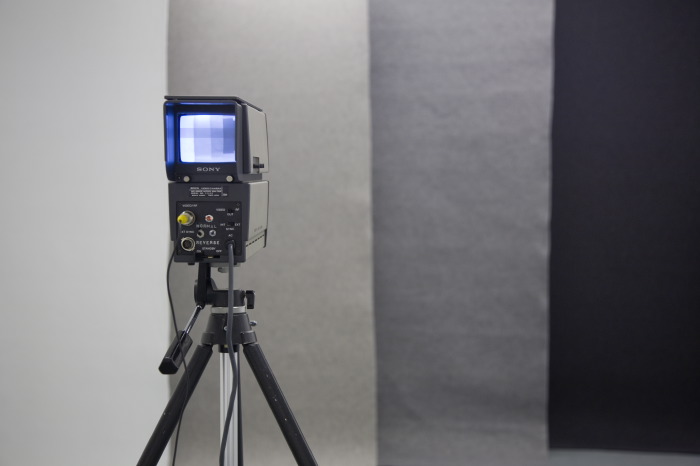
The tension of existing between states that Pattison appropriates to engage the audience exists in all of the works in this exhibition. In exhorting this tension, the artists reach out of the framework of institutional language to encourage us to incorporate their liminal gestures. The artist as maker calls on the existing framework to translate these actions from uninhibited visual experiences. As viewers, we reconcile the works with our previous experience, contextualizing what we see. As the liminal gesture expands the boundaries of acceptability, we are also able to reflect back on the course of art history to reinterpret the framework that has provided the context in the first place. By charting the use of these visual references, we understand the trajectory of art as an expansive language.
Ami Clarke creates works that allude to a linguistic structure that extends beyond themselves. She elaborates and reduces formations, abstracting their ability to be 'read'. Clarke has recently established an art library and project space in Hackneyand has exhibited with MOT Gallery and FormContent.
Dave Hanger appropriates ubiquitous everyday motifs and interprets them within a reductive form of abstraction. By using recognisable elements of our everyday visual vocabulary, he allows viewers a notional familiarity with his work which maintains its ambiguous form as it enters the gallery space. Hanger currently works at Cubitt and Studio Voltaire.
Yuri Pattison’s practice uses visual flags from media communications and foregrounds their formation with a deconstruction of the systematic technological mechanisms. A recent graduate of Goldsmiths College, Pattison has exhibited at the Woodmill and involved in a recent project with Resonance FM at the 2009 Frieze Art Fair.
Amikam Toren reworks objects to evaluate their potential content through a practice that is positioned between painting and sculpture, weighing the balance of comedy and critique. Often described as a painter, he manipulates this medium to explore moments of triviality and their relationship to recognisable canons. Toren has exhibited internationally, including the Serpentine, the ICA, IKON, Matt’s Gallery and Keith Talent Gallery.
Matthew Verdon’s practice often excavates the past in order to address it from a new perspective. Verdon re-assesses moments of intended positive social change and works to explore their newfound impact. He is currently pursuing his MFA degree at Goldsmiths College.
George Young’s work demonstrates an interchange between image and object. Subtle painting techniques and solidly-crafted wooden sculptural forms resembling canvas stretchers create a strong dialogue of multiple dimensions. Currently working at Cubitt Arts, Young recently won the Zoo 2009 John Jones Art on Paper Award and has exhibited at 176 Project Space, CRISP gallery.
